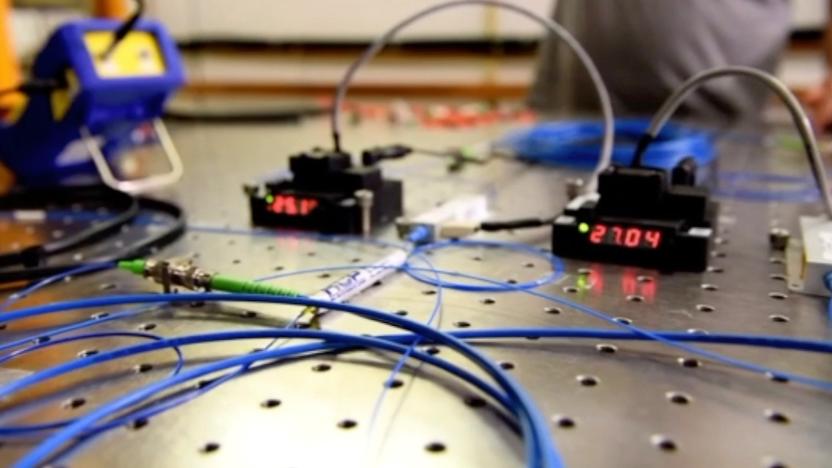quantum mechanics
Latest

Black hole 'quantum hair' might solve a decades-old scientific paradox
Scientists claim to have solved a scientific paradox by determining that black holes have 'quantum hair.'

A successful experiment gets us one step closer to a quantum internet
This week, a joint team of researchers made up of scientists from Caltech, the Department of Energy’s Fermilab, AT&T, Harvard University, NASA’s Jet Propulsion Lab and the University of Calgary announced that they successfully teleported qubits of photons across approximately 27 miles of fiber-optic cable.

Scientists unveil image of quantum entanglement for the first time ever
For the first time ever, physicists have captured an image of quantum entanglement. In a paper published in the journal of Scientific Advances, scientists from the University of Glasglow shared the first known image of a Bell entanglement. The photo depicts two photons interacting and sharing physical states for a brief instant -- an event that occurs regardless of the actual distance between the particles.

Physicists use diamonds to reach quantum teleportation breakthrough
Quantum teleportation promises a leap into the next great era of computing -- but first we've got to get it working consistently. Scientists at the Kavli Institute of Nanoscience Delft say they've managed to reliably teleport quantum info stored in one bit of diamond to another sitting three meters away (roughly 10 feet). Now, they want to go much farther.

Alt-week 8.4.12: buckyballs, bosons and bodily fluids
Alt-week peels back the covers on some of the more curious sci-tech stories from the last seven days. Remember when we told you last week that we live in a strange world? Well, we had no idea what we were talking about. Seriously, things are about to get a whole lot weirder. High school is certainly a head-scratcher, no matter how old you are, but the mathematics of social hierarchies can't hold a candle to the mysteries of the buckyball. And, if the strange behavior of the familiar carbon molecule isn't enough for you, we've got an entirely new molecule to contend with, while the once-elusive Higgs Boson is getting us closer to unlocking the secrets of the universe. It's all pretty heady stuff, which is why we're also gonna take a quick detour to the world of human waste. This is alt-week.

Flawed diamonds are perfect ingredients for quantum computing, just add time travel
Ready to suspend your brain cells in a superposition of disbelief? Good, because the latest news published in Nature is that diamonds are a quantum computer's best friend -- particularly if they're flawed. An international team of scientists sought out sub-atomic impurities in a 1mm-thick fragment of over-priced carbon and used these as qubits to perform successful calculations. A "rogue" nitrogen nucleus provided one qubit, while a free electron became a second. Unlike previous attempts at solid-state quantum computing, this new effort used an extra technique to protect the system from decoherence errors: microwave pulses were fired at the electron qubit to "time-reverse" inconsistencies in its spinning motion. Don't fully get it? Us neither. In any case, it probably won't stop jewellers tut-tutting to themselves.

University of Vienna researchers quantum leap into the cloud, ensure privacy for distributed computing
Afraid of the cloud? You're not alone, as rising concerns surrounding the security of distributed computing have led University of Vienna researchers to seek out quantum mechanics as a privacy fix. The team's findings, soon to be published in the journal Science, prove that an end user's data can remain encrypted throughout its journey to and from remote servers, essentially rendering the quantum computer's calculations as "blind." So, how exactly does this evasive entanglement work? Qubits (or quantum bits) containing the pertinent information are transmitted to a central facility where they're processed according to a specific set of measurements, leaving the resultant computations readable only by the original user. Not obtuse enough for you? Then check out the source below for a more detailed walkthrough.

Quantum entanglement could mean completely secure data transfer
By tapping into Albert Einstein's idea of "spooky action at a distance," researchers at the University of Copenhagen's Niels Bohr Institute have discovered what might be the key to completely secure data transfer -- keeping particles "entangled" for up to an hour. Until now, the link between two entangled systems could only be maintained for a fraction of a second. This development could enable a direct link between two systems of communication -- you do something to one and the other will "know." Although limited to the lab right now, scientists are working on practical applications for networking and the internets. Hey, SSH maybe it's time you started watching your back. Check out the full PR after the break. [Thanks Nan]

String theory finds an elegant use for itself with qubit entanglement and black holes
Sure, trying to wrap your head around string theory -- a study in particle physics that's trying to rectify the perceived contradictions between general relativity and quantum mechanics -- can cause more cognitive pain than a colliding god particle. That hasn't stopped anyone from trying to validate its corollaries, and in the interim, researchers like Michael Duff of the Imperial College London. Mr. Duff realized a few years ago there existed some strong relations between formulas pertaining to both black holes (relativity) and four entagled qubits (quantum mechanics). So, in his words, "In a way, there's bad news and good news in our paper. The bad news is, we're not describing the theory of everything. The good news is, we're making a very exact statement which is either right or wrong. There's no in between." We're sure some science cliques are already gearing up to get their troll on. Hit up the PDF below if you want to read it yourself.

Pressure-sensitive touchscreens show up on the not too distant horizon
Ever heard of quantum tunneling? It's the basis for the latest approach to gather steam in the never-ending quest to endue touchscreens with force recognition, and its promises are as lofty as you'd expect. Developed by UK researchers Peratech, this new methodology revolves around a 75-micrometer (less than a tenth of a millimeter) quantum tunneling composite, which display makers can add to their screens relatively cheaply and painlessly. The pressure-sensing layer consumes no power when it isn't depressed and requires a miniscule two micrometers of movement to register a touch. Japanese display maker Nissha (who counts LG and Nintendo among its customers) has grabbed a license and we're even hearing devices could be coming out as soon as April. Check the Peratech site for more info.

Learning quantum mechanics with Super Mario World
We love science, even if it totally creeps us out sometimes. Take, for example, this video explaining quantum mechanics and parallel universes via Super Mario World. Maybe Tyler Durden was right and we aren't unique snowflakes, after all. (It's okay, we're trying to hold back the tears, too.)Still, we love when science is dumbed down to our level (that is, explained using video games we know and love). This video, for example, teaches Hugh Everett's multiverse concept, using 134 overlaid playthroughs of a Super Mario World hack.We now conclude your Nintendo Wii Fanboy lesson for today (brought to you by the folks at PopSci); make sure to run off and tell your mothers what you've learned.[Via Gemaga]







